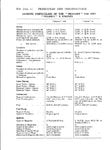In many british documents I have seen two different values for engine power ratings in same contitions.
For example (Flight: Feb. 16, 1939, in table page 155) :
Bristol Perseus XIIc:
Max. cruising: + 1.25 lb./sq.in., 2,250 rpm. 655/685 B.H.P @ S.L.
Max. climbing + 1.25 lb./sq.in., 2,250 rpm. 680/710 B.H.P @ 4,000 ft.
Max. take-off + 3 lb./sq.in., 2,700 rpm. 865/890 B.H.P @ S.L.
Max. eco. cruising - 1 lb./sq.in., 2,200 rpm. 530 B.H.P @ 9,000 ft.
Max. level flight (5 min) + 1.25lb./sq.in., 2,600 rpm. 815 B.H.P. @ 6000 ft.
Does somebody knows why first three power figures is given with two different values?
If I am thinking correct, it can't explane with a different fuel grade, because the boost figures is same and there is no two values for the Max. level flight power values. It can't explane at power with/without supercharger because then the difference of power must be higher in the take-off ratings.
Thanks for any help!
Regards
Keke
For example (Flight: Feb. 16, 1939, in table page 155) :
Bristol Perseus XIIc:
Max. cruising: + 1.25 lb./sq.in., 2,250 rpm. 655/685 B.H.P @ S.L.
Max. climbing + 1.25 lb./sq.in., 2,250 rpm. 680/710 B.H.P @ 4,000 ft.
Max. take-off + 3 lb./sq.in., 2,700 rpm. 865/890 B.H.P @ S.L.
Max. eco. cruising - 1 lb./sq.in., 2,200 rpm. 530 B.H.P @ 9,000 ft.
Max. level flight (5 min) + 1.25lb./sq.in., 2,600 rpm. 815 B.H.P. @ 6000 ft.
Does somebody knows why first three power figures is given with two different values?
If I am thinking correct, it can't explane with a different fuel grade, because the boost figures is same and there is no two values for the Max. level flight power values. It can't explane at power with/without supercharger because then the difference of power must be higher in the take-off ratings.
Thanks for any help!
Regards
Keke

